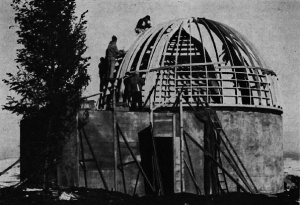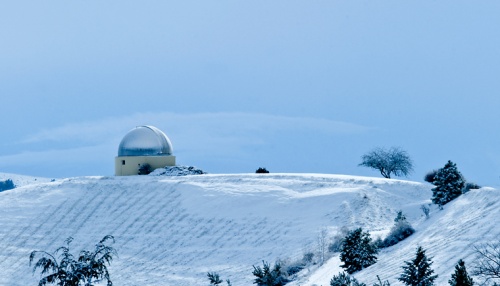Personal tools
Help
Class Notes
- Do you have news for fellow WSU alumni and other readers of Washington State Magazine? Send us your class note.
Our Story
written by alumni, faculty and friends.
NOTE: THIS IS A LEGACY SITE AND IS NOT REGULARLY MAINTAINED
Views
Observatory To Be Ready Soon, 1952
From Our Story
Posted June 2012
Sixty years ago, the Jewett Observatory on the campus of Washington State College was completed in 1952, after a long struggle to mount the lens for a refracting telescope in an observatory. George F. Jewett and his wife stepped in with a donation that enabled the observatory to be built.
Read the full history of the Jewett Observatory.
FromThe Powwow, WSC's alumni magazine, March 1952:
The James Richard Jewett Observatory is being built and equipped with funds donated to the College by Mr. and Mrs. George F. Jewett of Spokane. It is named in honor of Mr. Jewett’s father, late professor of ancient languages at Harvard University, who was himself an amateur astronomer. His own personal instrument is used for instructional purposes at Harvard and the Jewett family has also given that observatory funds for a telescope for advanced research studies.
The observatory of The State College of Washington is located on a high ridge in the southeast part of the campus. It is close enough to be easily accessible, yet sufficiently isolated to be free from light and smoke interference. It is made of poured concrete, with a 25-foot spherical plywood dome, and will house a refractor type telescope with a 12-inch lens.
The refracting type telescopes, which were invented by Galileo, make use of a lens, and are distinguished from reflectors, invented by Newton, which employ a mirror. The latter are the types of the largest telescopes, such as the 100-inch one at Mt. Wilson and the 200-inch at Mr. Palomar.
The 12-inch lens is a moderate size, suitable for the instructional uses to which it will be put. It will be available for use by the students of Washington State College, and it will also be available to other groups, such as high school students and civic organizations, on scheduled “public nights.” To some extent, it will be used for minor research programs by graduate students in astronomy and in the allied fields of mathematics, physics, and chemistry. The WSC instrument is very similar to those at Columbia University and Louisiana State University.
The telescope, which will have electrical clockwork to keep the stars properly aligned, is currently being tested at Tufts College, Medford, Massachusetts, under the supervision of Mr. Walter Locke and Professor Bart J. Bok of the Harvard University Observatory. It was made by the Alvan Clark company, long recognized in the field of optical instruments. The lens was made many years ago by Lundin, one of the finest opticians in the country, for a wealthy amateur who died before he could use it.
Of great assistance in procuring the lens for the Jewett Observatory was the late Mr. Leon Campbell of the Harvard University Observatory. Mr. Campbell was an outstanding observer of variable stars and a longtime friend of Professor Jewett.
The WSC observatory came into being after proposals to the administration and faculty by Dr. Sidney G. Hacker, WSC professor of mathematics, were approved in principle and, on the recommendation of the Board of Regents, became a part of the College’s planned program for the future.
When it happened that Mr. Campbell was able to locate the fine lens and the Clark firm indicated its willingness to build a suitable mounting, the Jewetts suggested to the College that they would be willing to finance the building and equipping of the observatory. It is the Jewetts’ intention to assume the entire expense for the building, the telescope, and the mounting.
The Jewett Observatory will have the first spherical plywood dome to be constructed for an observatory. This whole dome will be rotated electrically, while the slit for observation is operated manually. Philip E. Keene, College architect, and Glenn W. Wegner, of Keene’s office, are responsible for the architectural design of the building.
Two courses in astronomy are being taught this semester. The first, Descriptive Astronomy, is a class that grew from 33 students to 140 in a single semester. With the completion of the new observatory, offering increased facilities, it is expected that the enrollment will grow even larger.
A second course, Theoretical Astrophysics, which is open to advanced undergraduate and graduate students, has two staff members from the University of Idaho among the ten enrolled. This is a large enrollment for such a course, even on campuses where astronomy is a well-established course of study. From time to time, advanced courses are offered in mathematical astronomy and celestial mechanics. All astronomy courses are taught by Dr. Hacker.
With the gift of the James Richard Jewett Observatory, Mr. and Mrs. Jewett are helping The State College of Washington maintain its policy of service to the students and to the state.
Our Story site map
Our Story main page | Our Story categories | Help Desk
Contact | Give | Advertise
Washington State Magazine | Washington State University | Class Notes
Our Story is coordinated by
In partnership with
Our Story and Washington State Magazine are publications of Washington State University. All rights reserved.
P.O. Box 641227, Washington State University, Pullman, WA 99164-1227 USA | wsm@wsu.edu, 509-335-2388
Accessibility | Copyright | Policies


